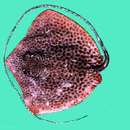fi
nimet breadcrumb-navigoinnissa


Die Gattung Himantura gehört zur Familie der Stechrochen (Dasyatidae). Die vier Arten der Gattung leben im westlichen Pazifik und im Indischen Ozean.
Himantura-Arten sind großwüchsig und werden 1,3 bis 1,6 Meter breit. Ihre Körperscheibe ist kräftig, und von subovaler bis rhombischer Form. Die Spitzen der Brustflossen sind breit abgerundet oder eckig. Die Schnauze hat eine weitwinkelige Form. Die Augen sind klein und stehen vor. Die Nasenöffnungen sind von rockförmigen Hautfalten umgeben. Der Schwanz ist peitschenartig und sehr lang. Er erreicht das 2,5- bis 3,7fache der der Körperscheibenbreite. Die Schwanzbasis ist schmal und im Querschnitt oval bis fast kreisrund. Der Stachel sitzt nahe der Schwanzbasis. Dorsale oder ventrale Hautfalten fehlen. Die Bauchflossen sind klein und werden fast vollständig von der Körperscheibe überdeckt. Im Nacken haben die Fische ein bis drei Reihen von Dornen. Außerdem ein undeutlich begrenztes Dornenband auf der Rückenmitte und einige kleine Dornen auf der übrigen Körperscheibe. Eine deutlich Dornenreihe auf dem Schwanz ist nicht vorhanden, lediglich bei adulten Exemplaren finden sich am Schwanzende einige kleine Dornen und Dentikeln.
Die dunkle Rückenseite der Himantura-Arten ist mit Flecken, Augenflecken oder Netzstrukturen deutlich gemustert. Die Bauchseite ist weiß. Bei Jungfischen ist der hintere Abschnitt des Schwanzes normalerweise gebändert.
Zur Gattung Himantura wurden ursprünglich über 20 Arten aus dem Indopazifik gezählt. Die meisten wurden in einer Mitte 2016 veröffentlichten Revision der Dasyatidae einigen neu eingeführten Gattungen (Brevitrygon, Fluvitrygon, Maculabatis, Pateobatis) oder Urogymnus zugeordnet. Heute gehören nur noch vier großwüchsige Arten zur Gattung Himantura. Eine davon ist noch unbeschrieben. Sie kommt in den Meeren um Australasien vor.
Die Gattung Himantura gehört zur Familie der Stechrochen (Dasyatidae). Die vier Arten der Gattung leben im westlichen Pazifik und im Indischen Ozean.
Himantura is a genus of stingray in the family Dasyatidae that is native to the Indo-Pacific. In a 2016 taxonomic revision, many of the species formerly assigned to Himantura were reassigned to other genera (Brevitrygon, Fluvitrygon, Maculabatis, Pateobatis, Styracura and Urogymnus).[1]
Four species are recognized as valid by some authors,[2] while other authors recognize five valid species.[3]
The fifth species, Himantura tutul (fine-spotted leopard whipray)[4] has had its validity disputed [5] and has been considered a junior synonym of H. uarnak by the Catalog of Fishes.[2] However, H. tutul was previously confused not with H. uarnak, but with H. leoparda, and subsequently shown to be genetically distinct and reproductively isolated from both H. uarnak and H. leoparda.[6][7][8] Both adult H. leoparda and H. tutul present leopard-like ocellated spots. These are smaller and less numerous in H. tutul.[4][6][7]
Himantura is a genus of stingray in the family Dasyatidae that is native to the Indo-Pacific. In a 2016 taxonomic revision, many of the species formerly assigned to Himantura were reassigned to other genera (Brevitrygon, Fluvitrygon, Maculabatis, Pateobatis, Styracura and Urogymnus).
Himantura est un genre de raies des eaux côtières des océans Indien et Pacifique. Une des espèces, Himantura uarnak est également présente le long des côtes du Levant en Méditerranée orientale.
Le nom de ce genre vient du grec iman, imantos, lanière, courroie et de oura, queue. Ce nom est de genre féminin.
Selon World Register of Marine Species (27 mars 2021)[1] :
Selon une révision récente du genre Himantura[2], ce dernier comprendrait sept espèces dont cinq sont déjà décrites (H. australis, H. leoparda, H. tutul, H. uarnak et H. undulata) et deux resteraient à nommer.
Himantura est un genre de raies des eaux côtières des océans Indien et Pacifique. Une des espèces, Himantura uarnak est également présente le long des côtes du Levant en Méditerranée orientale.
Le nom de ce genre vient du grec iman, imantos, lanière, courroie et de oura, queue. Ce nom est de genre féminin.
Himantura Müller ed Henle, 1837 è un genere di pesci cartilaginei della famiglia dei Dasiatidi.[1]
Le pastinache Himantura si distinguono dalle altre per avere una coda lunga e sottile e priva di pinnule. Le varie specie sono molto diverse morfologicamente e il genere potrebbe essere polifiletico.
Quasi tutte le specie sono originarie del Pacifico occidentale e dell'oceano Indiano[2].
Il genere comprende le seguenti specie:[1]